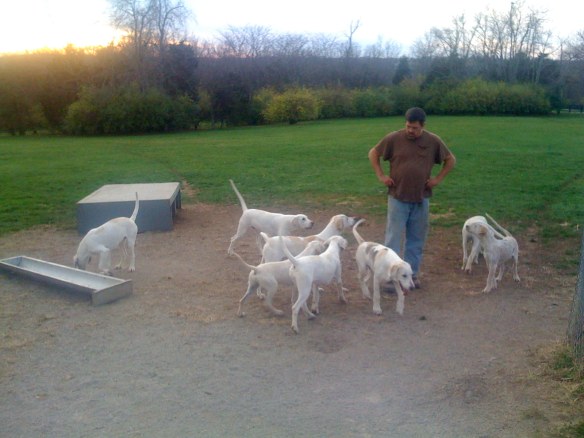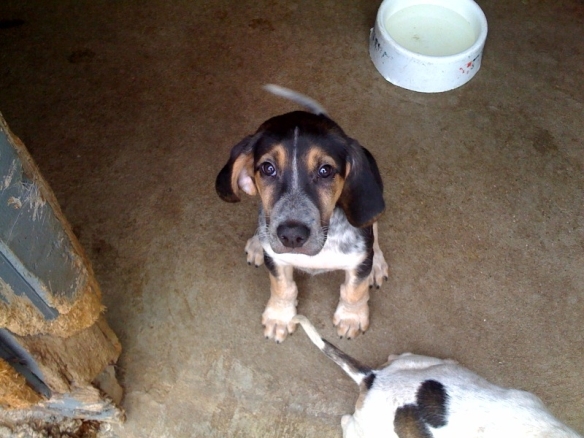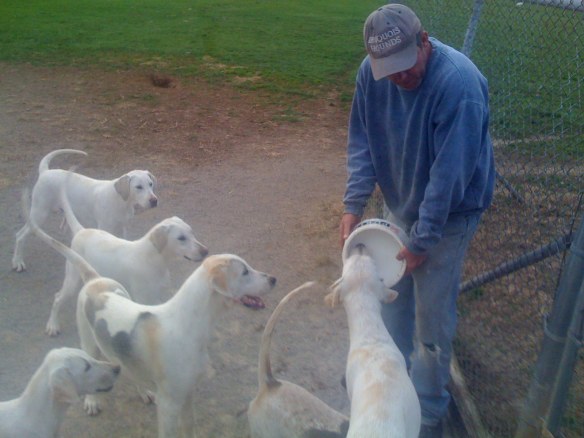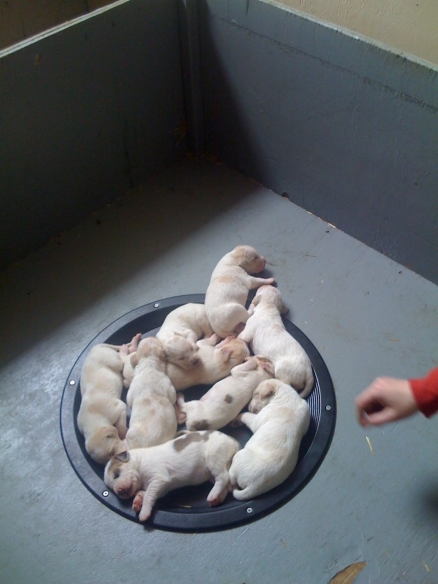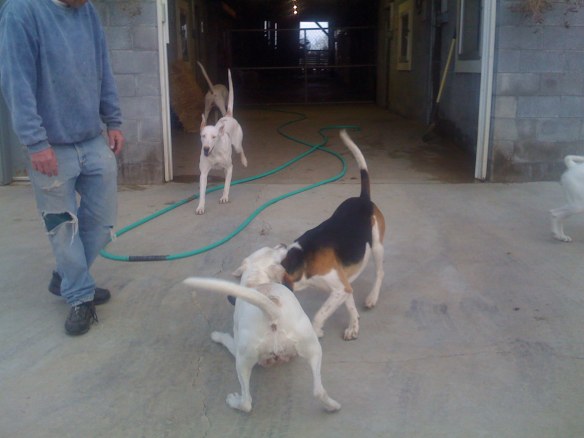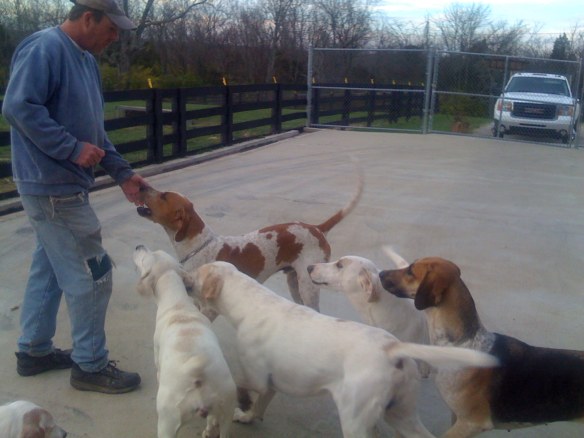
While the rest of the pack snuffled in the grass for their pre-hunt biscuits, Latch discovers that huntsman Lilla Mason has returned as huntsman. It was Lilla's first day carrying the horn since breaking her ankle in November. She's out of her cast, but not yet in her proper tan-topped boots because they don't fit over her swollen ankle.
The January 23 meet at Foxtrot was gray and damp. But it was a happy day for huntsman Lilla Mason, who picked up her horn again after almost three months on the sidelines.
When they rushed out of the hound trailer at the meet, the hounds went about their usual business–that is to say, they immediately sniffed around in the grass for the biscuits Michael Edwards and Alan Foy scatter at every meet (a pre-hunt biscuit or two helps prevent stomach acid build-up).
“It was such a thrill when the hounds got out of the trailer,” Lilla said. “Latch came running over to me and leaped up in the air, standing on her back legs and jumping up and down. It was like seeing old friends you haven’t seen long time. When I blew the horn, their heads snapped right up and they moved right off with me.
“Stanza was out in front of me, and when I said her name, she froze, turned and looked, then came running back. She ran a circle around my horse, then ran out and back again, like she was saying, ‘It’s you! You’re back!'”
Lilla has kept largely out of the hounds’s sight and hearing since she broke her ankle in November and handed the horn over to joint-Master Jerry Miller. Miller’s task since then was to maintain the pack without putting too much of his own imprint on them (read more about why and how he did that here). Did he accomplish that goal? The verdict from Lilla: yes.
“The best thing about the day I came back was that I could tell by the hounds’ demeanor and body language that they were the same as when I got hurt,” Lilla explained. “That was so meaningful to me. If someone other than Jerry had taken them over and managed them differently, it would have been heartbreaking if the hounds had cowered or been different when I came back. After an absence, you wonder, ‘Are we all going to be on the same page mentally?’ And we were. They were the same pack they were when I left: confident, enthusiastic, obedient, just as they were when I left them in November. I’m very thankful to Jerry for that.”

Before the hunt, Lilla tells the whippers-in, including road whips Michael and Alan, her planned route and directs them to where they are most needed.
The conditions were … I guess “gooey” would be the technical term. We’ve had drenching rains all winter, and the ground was deep. It was only thanks to a generous landowner that we were able to hold the meet at Foxtrot, and it turned out to be a showcase for how complex and important Michael and Alan’s work really is on a hunt day.
Lilla and the whippers-in all carry radios, and so do Michael and Alan. That communications network is solely for the hounds’ protection. It allows Lilla to direct the whippers-in even over long distances when they are out of sight, allows Michael and Alan to position themselves along a stretch of road where a coyote (and thus the hounds) might try to cross, and allows everyone to communicate and get to hounds as needed.
I hopped in Michael’s truck once the hounds had moved off. When Lilla radioed that the hounds were heading into the Silo Covert, Michael drove on top of a rise to the south of the covert. From there, we could view a wide swath of landscape, keep tabs on the hounds, and speed back toward any of three roads that border that part of the country, if need be. Alan, in a second truck, was stationed exactly opposite our position, watching north and east across the same acreage.
“We always like to keep the hounds between us,” Michael explained.

The radio, seen here in a leather case attached to the saddle, is an important part of a whipper-in's equipment. The hunt staff, including Michael and Alan in their trucks guarding the roads, use radios to coordinate their positions in order to protect the hounds
We sat watching and waiting, following Lilla’s radio reports as she tried a few coverts without finding anything. Then she brought the hounds to Junior’s Scrub, a brushy area with a thickety treeline and tall grass. Suddenly: coyote scent. The hounds’ noses played rapidly along the ground, searching, trying to parse out the coyote’s path. The hounds’ movements became electric, and they waved their tails quickly from side to side, feathering, a sure sign that they smelled something.
Lilla’s voice crackled over the radio: “Hounds are in Junior’s Scrub. They’re really feathering. Bonus and Stifle are really trying to work something out.”
“It was one of those days when air is dead still,” Lilla said later. “Sound really carries on a still day like that, and I could even hear the traffic from all the way out on the interstate. I thought I’d try moving through coverts a little more quickly, because surely the coyotes would hear us coming. When the hounds came in to Junior’s Scrub and started feathering, my heart started beating.
“I thought might be an old, cold line. So I waited to let them work it out. When the hounds started to feather, I didn’t move my horse forward with them, because any sound would echo through the still air, and I didn’t want to to distract them. There was something there, but they couldn’t quite work it out, and I wanted to give them ample room and opportunity. The field was quiet too, which was helpful.”
And then, all at once, the hounds struck off.
“It was like a clap of thunder,” Lilla said. “There was no preliminary yipping, it was just BAM and they were off–really thrilling. I knew they’d worked the line out and were right on top of whatever it was.
“But it was like a bad dream, too, because the mud was so deep,” Lilla added. “The horses were being so careful, and you almost had to push them into a canter. It was slippery, and they had to take it down a gear, where on a regular day you could have run on. We just couldn’t move fast enough.”
As the hounds shot away from them, Lilla and the field on their horses were mired down, slowed by the heavy ground. Jumping coops was out of the question, and even getting through gates proved tricky.
“It was very slick in the gateways where the tractors had gone through the gates, and some of the ground was still frozen, so it was treacherous going,” Lilla said. “We ended up far behind the hounds. It was a good example of why things are different when you’re hunting coyotes. Unlike foxes, coyotes just get out of there so fast. It’s harder to protect hounds’ safety on days like that because you can’t push your horse and can’t get to the hounds as quickly as you could on days when the footing is better.
“We knew the footing wouldn’t be great that day, but I didn’t think it would be that deep. Still, we had to get the hounds out.”
Two coyotes had run simultaneously out of Junior’s Scrub, one heading west and the other south, a common tactic coyotes often use to confuse a pursuer. This time, the ploy didn’t work especially well, because the main body of the pack, 15 hounds, stayed together in pursuit of the southbound coyote. One hound, young Griffin, headed west after the other.
From where we sat in his truck on the hill, Michael and I couldn’t hear the spine-tingling sound of the pack until Lilla came back on the radio, breathlessly giving directions at a gallop. In the background we could hear the pack, too, off in the distance.
“This is my favorite part of the hunt, even though I don’t see a lot of it,” Michael said. “This is what it’s all about.”
We sat tight for a moment, tensely listening for the next update that would tell us which direction hounds were running, and therefore which way we should head.
The radio crackled again, but this time it was all a muddle of strong wind, flapping saddle leather, and an unintelligible voice calling out. Static. More wind, and then the signal clarified into the voice of one of the whippers-in: “Tally-ho! They’re right on it!”
Another whipper-in cut in to say the hounds had turned south and were running along the banks of a wide creek, just at the bottom of coyote-rich Pauline’s Ridge. There was a pause when hounds lost the scent and wheeled around like a school of fish, tails feathering busily as they searched silently for the coyote’s line, and then full cry again! The whipper-in closest to the hounds reported the pack had climbed the ridge and turned east at the top.
Back on the road, Michael headed east, too, the radio signal fading out and in again as we negotiated turns and crested hills. Committing to the east was a gamble, as all decisions on the hunt field are, but it put Michael in a flexible position if hounds switched direction and headed south again, something Michael thought was a strong possibility. “If they keep going east, I’ll be right in position,” Michael explained. “If they head back south, from this road I can get south pretty fast.”
We roared along, waving to landowners as we rushed by and keeping our eyes open for the hunted coyote. Instead, we saw ponds, flocks of Canada geese, horses grazing peacefully in their paddocks. At one point we passed a yard where three house dogs sat in a line, bolt upright and ears pricked, clearly tuning in to the distant cry of the foxhound pack.
All seemed quiet and pastoral outside our windows, but inside the truck the excited radio transmissions described a dramatic chase as it unfolded. Radio messages poured in from Lilla, from whips in their various positions, from Alan in his own truck as they spotted hounds, heard hounds, or requested information to adjust their positions.
Then hounds did indeed turn again, as Michael thought they might, and headed back south–a path that would bring them onto a busy road if they didn’t lose the line first. Michael detoured onto the back roads, taking a short-cut to the street in question, near the hunt country’s southern border. Our goal now was to get to the road before the hounds did and stop any oncoming traffic.
And then, as we came up a hill to the place where Michael anticipated coyote and hounds might try to cross, we saw it: the coyote, a big one with a heavy coat highlighted with tawny gold. He loped along across the top of a ridge we call Smitha’s Cliff, too far away for me to catch on camera, then disappeared into a dip near the road. The next few minutes were frantic. Hounds, no longer speaking but still on the line of the coyote, appeared on the ridge and ran on. We backtracked, and so did Alan, just in time to see the coyote cross the road. That, we now knew, was the path the hounds would take, too. Michael and Alan braked, hopped out of their trucks, and stationed themselves along the road, arms spread wide, to stop oncoming cars and trucks.
Before they reached the guard rail on the road’s north side, the hounds were speaking again. They squirmed under the rail and screamed across the road, barely conscious of us as they passed. They were focused on one thing: following that coyote.
The coyote, meanwhile, had leaped up the rocky hillside on the opposite side of the road. He still had a significant lead over the hounds, and he made good use of it, skipping over the top of the ridge and disappearing. The hounds streamed after him but went silent along the top of the ridge, out of our sight. Their quarry evidently had made it to safety in a hole among the rocks and trees, and the hounds gradually began to filter back down the hillside toward the road again.
Lilla, hampered by the treacherous ground, was riding five or ten minutes minutes behind the hounds and still hadn’t made it to the road. By the time she arrived, Michael and Alan had held the road safe for the hounds. Lilla decided that, given the exhausting ground conditions, it was best to call it a day after a ripping welcome-back coyote run.
By day’s end, horses had gone 16 miles round trip over some of the most testing ground the hunt had ever faced.
Michael and Alan, who carry tracking equipment to track any hounds that are late in returning, loaded up the hounds. The hounds were damp from running through the wet thickets and mud. A few ears were scratched by brambles, but the hounds’ eyes shone with the startling intensity that working hounds are famous for. Sayso, below, is a good example. She came back when called, but her eyes suggest that, in her mind, she was still homing in on that coyote.

Sayso, a daughter of our beloved Stalker. She picked up some bramble scratches on her ear in the thick coverts, but she doesn't appear to care. How about those amazing eyes!
We headed back to the kennel, but for the kennel guys the day was far from done. While Alan attended to the hounds he’d picked up, returning them to the hound trailer at the meet, Michael pulled into a nearby farm to make sure a farmer’s gate we’d used was shut and locked, as the farmer wanted it. Michael counted up hounds as he went, to make sure everyone was accounted for. Griffin, the hound that followed the westbound coyote by himself at the start of the run, had hooked up with the hilltoppers, and Michael wanted to be sure he’d returned to the meet with them without incident.
Poor Griffin missed all the excitement. He eventually lost his coyote and came back looking for the rest of the pack, who had followed the southbound coyote. Along his way, he met up with the hilltoppers, who had not kept up with the first flight and therefore couldn’t return him to the pack. Horses, at least, were familiar, so he stayed with them until the end of the day when he was reunited with the pack back at the meet.
Joint-Master Miller confirmed for Michael that Griffin was safely in, and then Michael drove back to make sure the road signs warning about horses and hounds had also been collected; they had.
Back at the kennels, the hunting hounds still needed their dinner, as well as a thorough examination to be sure bramble scratches were the only things the hounds had picked up on their run across country. The hounds that hadn’t hunted also were waiting for their turnout time in the paddock. The puppies, having spent several hours out, were now ready to come back in.
It was, like most days at the kennel, a long day for Alan and Michael. But it was worthwhile, especially knowing that the hounds they care for had performed so well.
“This is a blast to me,” Michael said. “It’s what I live for, chasing these hounds. I get depressed just like they do if the weather’s bad and we can’t hunt. We spend the whole year getting them ready for this, it’s what they’re about and what I’m about, and I love it.”







